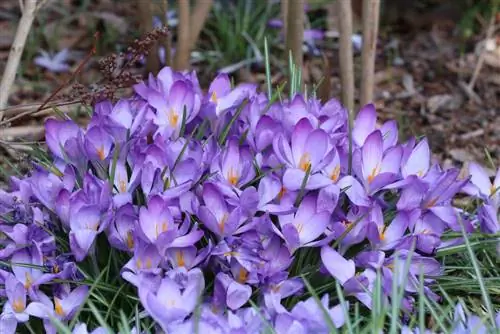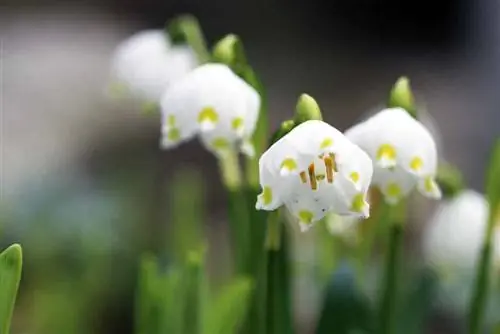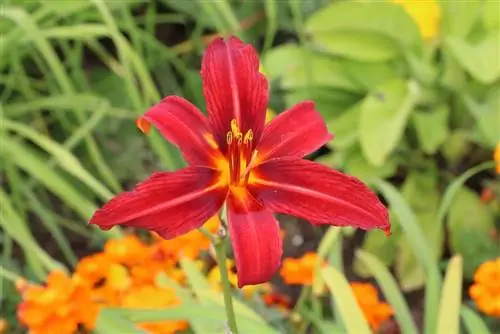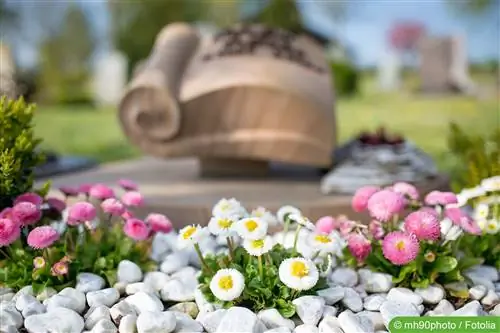- Author admin [email protected].
- Public 2023-12-17 03:39.
- Last modified 2025-01-24 12:45.
When a busy gardening year comes to an end in autumn, experienced hobby gardeners do not miss the preparation of early blossoms for the coming season. The reward for this foresight is the cheerful, colorful carpets of flowers that herald spring when the garden is still in deep hibernation. The following instructions will tell you in detail how to skillfully plant spring bloomers. The attached list of colors invites you to browse to design creative plant arrangements.
Planting instructions
Although all spring bloomers are characterized by their undemanding nature, some fundamental requirements must be taken into account when planting. First, the chosen location comes into focus, which should meet some minimum requirements. In addition, the time window is clearly defined when the flower bulbs should be placed in the ground. Last but not least, professional soil preparation creates ideal conditions for growth.
Site and soil preparation
The range of enchanting spring bloomers is wide-ranging and extends from delicate crocuses to majestic daffodils. What all of these flower beauties have in common are largely uniform location requirements.
- Sunny to semi-shady location
- Ideally protected from strong winds and pelting rain
- Humose, permeable and loose soil, rich in nutrients
- Fresh, moist, slightly sandy and without the risk of waterlogging
Before planting, the soil is thoroughly raked and tilled into fine crumbs. Heavy soil is optimized with a little sand, while dry, sandy soil is enriched with sifted compost.
Planting time
The best planting time for spring bloomers is from September to December. A distinction should be made between the types of flowers that are the first to blink towards the sun and the varieties that follow later. Crocuses, snowdrops and winter aconites come into the ground as early as September and October. For late bloomers, such as tulips or irises, you can take your time until December, as long as the ground is not yet frozen.
Tip:
Hyacinths can be grown wonderfully in specially made glass containers in the house. So you can enjoy the flowers in winter before you plant these spring bloomers in the garden.
Plants
After preparing the soil, the actual planting is very easy. How to do it right:
- Dig small holes up to a depth of approx. 10 cm
- Insert the flower bulbs with the tip facing upwards
- A planting distance of 5 to 7 cm is considered ideal
- Set in small tuffs, the onions must not touch each other
At the end, each spring bloomer should be covered with soil at least 5 cm. After you have pressed the soil a little, watering continues. Planting in pots and flower boxes is similar, although drainage over the water outlet is important. This preferably consists of inorganic, coarse material, such as pebbles, grit or pottery shards. So that no soil crumbs from the substrate get stuck in it, experienced hobby gardeners insert a water- and air-permeable fleece.
Tip:
A thick layer of peat moss protects the freshly planted flower bulbs from severe frost.
Protection from voles
If a garden is regularly infested by voles, the following preventive measure is recommended. Use special wire baskets to keep the voracious pests away from the juicy flower bulbs. Specialist retailers have various vole baskets available that are constructed from a fine-meshed rectangular wire. A lid is not necessary as voles do not penetrate to the surface. This is how it is used:
- Dig a planting hole up to 15 cm deep - insert the vole basket in it
- Spread a 2 cm high layer of sand on the ground
- Pour the excavated material over it and insert the flower bulbs
After you have watered the soil, the planting site is marked. This way you can ensure that no one accidentally digs up here in the fall or winter.
List of colors
The following overview presents the most important spring bloomers and names the corresponding common colors:
Crocus (Crocus)
This classic blooms from February onwards and sometimes even peeks out through a blanket of snow. With a height of 10 centimeters, the tiny little one finds a place everywhere.
Colors: white, violet, golden yellow, lavender, purple
Snow shine (Chionodoxa forbesii)
With countless star blossoms, this spring bloomer forms carpets of flowers from March onwards as far as the eye can see. Thanks to a growth height of up to 25 centimeters, it cannot be overlooked.
Colors: blue, purple or pink, each with a white eye or pure white
Snowdrop (Galanthus)

From February onwards, the cheerful snowdrops drive away the gray dreariness of winter from the garden. Where previously there were dark, shady beds, there is now a dense carpet of flowers. Nobody wants to be without the lively snowdrops with their growth height of 10 to 15 centimeters in the late winter garden.
Color: white
Spring Anemone (Anemone blanda)
It cannot be missing from the crowd of classic spring bloomers. The charming anemone arrives in March and stretches up to 15 centimeters in height.
Colors: white, white-green, blue, pink, golden yellow
Dwarf Iris (Iris histrioides)
Native to the rugged mountains of the Caucasus, this small species of iris brings colorful spring greetings to the rock garden and gravel bed. With a maximum height of 15 centimeters, the name couldn't be chosen more appropriately.
Colors: blue in every conceivable shade
Grape Hyacinths (Muscari)
With its graceful shape, the grape hyacinth decorates the bed well into April. When planted under trees or in perennial beds, it creates pretty splashes of color with a growth height of 15 to 20 centimeters.
Colors: white, blue, violet
Checkerboard flower (Fritillaria meleagris)
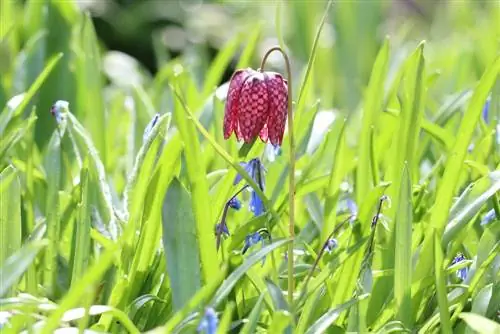
From March to May, the checkerboard flower presents itself decoratively with its nodding bell blossoms. Since it tolerates moisture well, it thrives along the stream or on the banks of the garden pond. Here it attracts everyone's attention with a growth height of up to 30 centimeters.
Colors: white, purple, violet, plum blue, always drawn like a small chessboard
Märzenbrecher (Leucojum vernum)
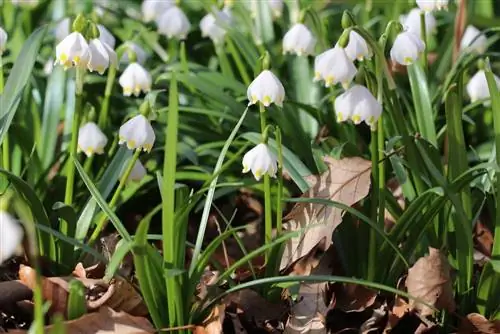
Their bell-shaped flowers spread a nostalgic flair in the bed and flower box. From a distance, Märzenbrecher are often confused with snowdrops, but they are twice as tall as them, reaching a height of 30 centimeters. In the company of anemones and crocuses, magical combinations emerge.
Colors: white with green
Daffodil (Narcissus)
An Easter without daffodils is unthinkable. From April onwards, the enchanting spring flowers shine in a wide variety of heights from a tiny 10 centimeters to an impressive 45 centimeters.
Colors: white or yellow in different shades
Tulip (Tulipa)
They not only impress with their exuberant colors, but also exude an intoxicating scent. Tulips belong in every spring garden, whether it is as small as a towel or epic in size.
Colors: white, cream, red, pink, red-white striped, orange, yellow, magenta, violet, purple, purple, black
Imperial Crown (Fritillaria)
From April onwards, they proudly stand out from the bed with a height of up to 80 centimeters. Their mighty crown flowers are visible from afar and sit on strong stems that no gust of wind can easily knock over. Their unique beauty is paired with a tangible benefit for troubled hobby gardeners, as the smell drives away moles and voles.
Colors: yellow, orange-red
Conclusion
Anyone who gets up again in the fall to plant the spring bloomers will be rewarded with lush colors from February onwards. Regardless of the almost inexhaustible variety of species and varieties, there are uniform instructions for planting flower bulbs. In a sunny to partially shaded location, in nutrient-rich, fresh, moist soil, plant the harbingers of spring 10-15 cm deep into the ground between September and December. As long as the tip of the bulb points towards the sky, the colorful flowers unfold in beautiful colors, which this list provides information about.
Additional 20 tips for spring bloomers
- Flower bulbs for spring bloomers are planted in autumn.
- The best planting time is between September and October, definitely before frost.
- If the bulbs are planted early enough, they have enough time to form roots. This way they can get started and bloom early enough.
- If you plant too late, the flowering period is usually postponed. That's not a bad thing, but it's often quite warm and sunny and the flowers don't last long.
- You loosen the soil in the bed a little before putting in the onions.
- Weeds must be removed!
- The correct planting depth is important. It is usually stated on the packaging. The planting depths are often quite different.
- The tip of the onion must point upwards!
- The planting substrate should be permeable. If there is too much moisture, the onions can rot.
- It is good to mix some sand into the ground.
- Water the soil after planting!
- You can also plant spring-flowering bulbs in flower boxes. You use good soil, plant the onions and water. The box or planter should be positioned so that the soil is not too moist. Too dry doesn't do much harm, too wet is dangerous!
Spring perennials
Spring perennials can be bought in spring in nurseries, flower shops and hardware and garden stores. Unless there is still frost, they can be placed straight into the garden or into planters. Many of the plants can also be purchased in the fall, often cheaply online. However, it is not certain that the plants planted late will still grow and survive the winter unscathed.
- The plants are usually advanced. You can get them very early in the year.
- For plants that have been sprouted, it must be expected that they will not tolerate frost. So if real frost occurs again, the plants must be protected!
- When purchasing, always ask whether the spring bloomers can already be planted out or placed outdoors!
- The soil around the planting site should be loosened and freed from weeds.
- Depending on the plant, you have to know that they form large cushions. So you need space. Don't plant too close together.
- Spring perennials are also suitable for balcony boxes and planters. Here you can put together beautiful plant arrangements.
- If you use new potting soil, you don't have to fertilize for the first 4 to 6 weeks, it already contains fertilizer.
- Don't keep the planters too wet

